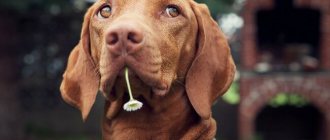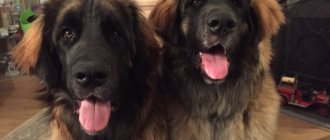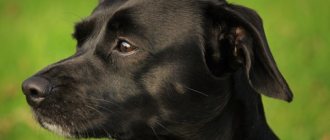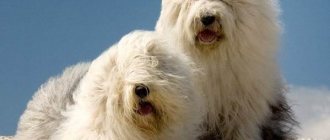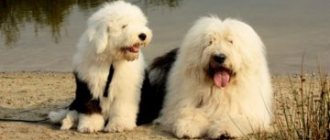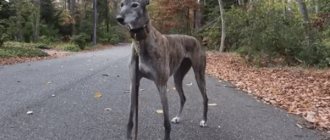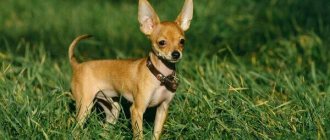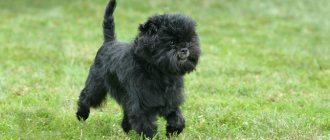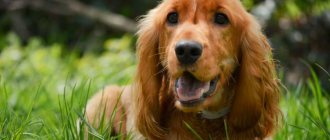Mudi are small dogs with pointed ears and a compact body covered in shiny, curly hair. During their existence, they have proven themselves well as shepherds, easily managing numerous herds, and now they perform guard duty and live in families as pets.
Let's find out what Mudi are and what the specifics of keeping the breed are.
Breed description, standards, appearance
The Mudi or Hungarian Cattle Dog is a compact, strongly built animal with a wedge-shaped head and a cunning expression in slightly slanted eyes.
According to the international classification, the breed is classified in group 1 “Guard and racing dogs (with the exception of Swiss herding dogs)”, section 1 “Shepherd dogs” without testing working qualities.
Size and constitution
Mudi is a medium-sized breed with moderate sexual dimorphism. The male Hungarian Cattle Dog grows to 41-47 cm at the withers and weighs 11-13 kg. The height of the female is 38-44 cm and weighs 8-11 kg.
According to FCI Standard No. 238 of 2004, a typical Mudi dog must meet the following description:
- The head is wedge-shaped with a domed skull, poorly defined stop, poorly developed eyebrows and occipital protuberance. The lips are close-fitting with uneven, slightly jagged corners. The teeth are small, white, healthy, complete. Scissor bite.
- The nose has a straight back and a narrow, rounded lobe with moderately wide nostrils. The color depends on the base color. With a fawn, black, white or blue merle coat, the nose is only black. In brown mudies it is brown, in gray ones it is gray.
- The ears are V-shaped, erect, and set high. Abundantly covered with thick hair protruding beyond the edges. Mudi can unfold his ears independently of each other.
- The eyes are narrow, slightly slanted with dense, close-fitting eyelids and a dark iris. Heterochromia is allowed in blue and white mudies.
- The body is compact with a clear slope towards the croup, pronounced withers, a straight, short back, a strong loin and a short, muscular croup. The abdomen is moderately tucked.
- The limbs are smooth, strong, muscular with rounded paws, tightly closed toes, springy pads and hard, bluish-gray claws. Mincing movements.
- The tail is set high, abundantly covered with hair up to 10-12 cm long. When calm, it hangs, bending horizontally in the lower third. When moving or alert, it rises above the line of the back, taking on a crescent shape. It can be docked so that 2-3 vertebrae are visible.
Disqualifying defects, in the presence of which a Mudi cannot take part in exhibitions and is removed from the breeding program, include:
- drooping ears;
- yellow eyes (black dogs);
- cryptorchidism (in males);
- jaw misalignment, undershot/overshot;
- pigmentation of the nose that does not match the coat color;
- height above 47 cm and below 38 cm at the withers;
- absence of incisors, canines, molars 1-2 or premolars 2-4.
Color and coat type
Mudi are covered with thick, shiny hair, the length of which varies on different parts of the body. The shortest spine grows on the head and the front surface of the limbs. In other parts of the body of Hungarian herding dogs, the coat is slightly curly or forms uniform, well-defined waves.
The back of the forearm and thigh are covered with the longest hair.
On a note. A matte, smooth, short or straight coat is considered a serious fault and is grounds for disqualifying the dog.
According to the Mudi standard, several color options are allowed, including:
- black;
- pale yellow;
- white;
- brown;
- ashen;
- blue merle (with black markings on a bluish-gray background).
For any color variant, the Mudi is allowed to have small white markings on the dog’s toes, body and chest.
Price
When selling dogs, the kennel guarantees their pedigree, their health and suitability for breeding. Throughout the dog’s life, breeders from nurseries are ready to answer many questions, help with participation in exhibitions, and in selecting a groom/bride.
If you buy a dog second-hand, then such help and guarantee will no longer be available. It is advisable to apply for puppies only to nurseries that specialize in this breed. For less than 25 thousand rubles, you can only buy a puppy secondhand, without documents or with a breed defect.
The price corresponding to the breed characteristics and qualities of the Hungarian Vizsla, with ready-made documents and vaccinations, starts from 30 thousand rubles. Show-class puppies, promising for a show career, born from champion parents, are sold for 60-70 thousand rubles.
Mudi character and behavior
The Mudi is an intelligent, assertive and alert dog with an energetic temperament and strong watchdog instincts. She easily adapts to a new environment and enthusiastically undertakes to carry out any household assignment.
The Hungarian Cattle Dog quickly becomes attached to people and needs constant communication with members of the household. Although the Mudi is affectionate and friendly towards all family members, it chooses one owner and maintains a close bond with him.
The Hungarian Cattle Dog is distrustful and sometimes wary of strangers. Moody may not approach a stranger until she is sure that he does not intend to harm her.
Breed and children
The affectionate and neat Hungarian Cattle Dog is very friendly with children, but will not allow them to hurt him. In addition, while playing with children, the mudy's natural instincts may awaken, and she will begin to “graze” and bite them.
Breed and other animals
Mudi gets along well with other dogs, especially if she was raised with them. But if kept together with cats, rodents and ornamental birds, problems may arise.
Key points in training
Komondors are an easy to train breed, but a beginner may find their willful nature difficult to cope with. Shepherd dogs tend to make independent decisions; complete obedience is possible only if the dog recognizes the absolute authority of the owner. The main work of education is aimed at this. You can resort to the help of experienced dog handlers.
The puppy is accustomed to a place to sleep, a name, a collar and leash, time for walking and feeding . Small Komondors are very playful, but become more serious as they age. Therefore, only early training can interest these dogs.
Read about how to properly train a dog in the article: “Training a puppy: effective methods from dog handlers, learning commands at home.”
It is important to socialize the shepherd so that it can get used to the people and pets around it and does not show spontaneous aggression.
A Brief History of the Origin of Mudi
The history of the breed began in Hungary in the 17th century. True, in those days no one was engaged in targeted selection. The Hungarians simply needed brave herding dogs capable of managing sheep flocks.
Therefore, shepherds tried to select dogs with the required skills and practiced interbreeding.
Puli, Pumi, German Schaffoodles and Croatian Shepherds took part in the formation of Mudi. They began to be bred as a separate breed only in the 19th century, and the first standard appeared in 1936.
The Second World War threatened the existence of the Mudi, and by the time peace was established, the population of Hungarian herding dogs amounted to only a few. To restore the breed, breeders added blood from Belgian Shepherds and Border Collies to it.
As a result of such crossing, the exterior of the Mudi has undergone significant changes, which required an adjustment to the standard. Now the breed is officially recognized by all leading canine associations, including the International Film Festival, the American and English Kennel Clubs.
Care and maintenance of Mudi
Mudi is small in size and adapts equally well to both apartment and street life. However, in the first case, the dog will have to be regularly taken for walks, without which it will acquire bad habits.
When kept outdoors, Mudi cannot be kept in an enclosure all the time. The Hungarian Cattle Dog should be able to move freely around the yard and enter the house.
Hygiene procedures
Mudi has a wavy coat that is not prone to matting and does not require complex grooming. To keep the Hungarian Cattle Dog looking neat, it is brushed 2-3 times a week with a special brush or comb.
During molting, which occurs during the off-season, the procedure is carried out more often in order to quickly get rid of dead hairs.
Mudies are bathed no more than 3-4 times a year, so as not to wash off the natural protective layer. For bath procedures, gentle veterinary shampoos are used that do not dry out the skin.
Mudi's erect ears are constantly filled with dust. To prevent an environment favorable for the development of pathogenic microflora to be created inside, they are cleaned 2-3 times a week with cotton swabs moistened with hydrogen peroxide or chlorhexidine.
Natural discharge accumulates in the corners of the eyes of a mudi, which is wiped off daily with a linen napkin moistened with unsweetened strong tea or chamomile infusion.
If a Mudi moves a lot on hard surfaces, its claws wear down on their own. Otherwise, they are regularly shortened with a nail clipper, trying not to touch living tissue. If this is not done, then overgrown claws will interfere with the Hungarian Cattle Dog’s movement and can cause joint diseases.
Feeding
Mudi are not picky dogs, consuming both dry and natural food with the same appetite. They eat in moderate portions, so it is easier to feed them with ready-made industrial mixtures.
When purchasing a dryer for a Hungarian Cattle Dog, it is advisable to give preference to imported premium or super-premium products, such as Brut Care, Carnilove or Belcando. It is easy to use, does not require special storage conditions and contains a full range of vitamins and minerals.
If a Mudi eats natural food, its diet should consist of 70-80% beef or lean lamb. It is advisable that it is not a selected cut, but sinewy meat with cartilage. Twice a week it is useful to give the mudi giblets and fillets of sea fish. It is also recommended to give the Hungarian Cattle Dog:
- eggs;
- cereals;
- vegetables;
- sour milk.
Poor nutrition can cause gastrointestinal upset in a mudi. Therefore, fatty meats, river fish, sausages, exotic fruits, baked goods and any dishes from the master’s table are completely excluded from the diet of the Hungarian shepherd dog.
On a note. When planning a natural menu for mudi, it is almost impossible to maintain a balance of nutrients. Therefore, to prevent vitamin deficiency, Hungarian shepherd dogs are given mineral complexes in courses twice a year.
Walking and exercise
Mudi is an active and resilient dog with an energetic temperament. To maintain muscle tone and good physical shape, she needs daily walks with a total duration of at least 2 hours a day.
When outdoors with a Hungarian shepherd dog, it is not enough to leisurely walk along the paths and admire the surroundings. Mudi needs active games, such as running after a ball or jumping over obstacles.
To prevent the Hungarian Cattle Dog from suffering from lack of exercise, it can be involved in morning jogging, cycling or agility classes.
Training and education
Mudi is an intellectually developed dog, ready to interact with humans. She willingly makes contact and easily masters the wisdom of training. When raising a Hungarian shepherd dog, you should remember that it does not tolerate cruelty and in response to rough treatment it becomes stubborn.
It is better to train a Mudi in a playful way, not forgetting to reward the animal. Unlike most other breeds, the Hungarian Cattle Dog responds better to verbal praise rather than treats.
On a note. Without any real work to do, the Mudi can become fussy and noisy. Therefore, she needs to be regularly given mental exercise and not allowed to bark over trifles.
Puberty and mating
Mudi become sexually mature at 6-9 months, but are fully formed only by 2 years. In order for a Hungarian shepherd dog to bear and feed strong puppies, it is recommended to breed it no earlier than 2 years.
Absolutely healthy animals with a stable psyche, pedigree exterior and good pedigree are selected for mating.
Mating is organized on the 10-13th day from the start of estrus and is repeated after 1-2 days. In order for the male Mudi to act confidently, mating is carried out on his territory, after walking and introducing the dogs.
Pregnancy in a Mudi lasts on average 58-63 days and ends in natural birth, which occurs without complications. Typically, a Hungarian Cattle Dog litter contains 4-8 puppies.
Caring for puppies
A Mudi puppy from a good nursery moves to a new home no earlier than he is 2-3 months old. Therefore, future owners have enough time to buy a “dowry” for their pet. To make caring for your puppy easier, it is recommended to purchase in advance:
- mattress with removable covers;
- bowls for food and water;
- several different toys;
- hygienic cosmetics;
- grooming tools.
It is better to place the bedding on which the Mudi puppy will sleep away from drafts and radiators. And so that the baby does not miss his mother so much, you need to place on his bed a little thing with the smell of a “native nest”, which you can ask from the breeder.
To prevent the Hungarian shepherd dog puppy from accidentally getting injured while exploring a new home, household chemicals, wires, medicines and breakable decorative elements are prudently hidden from him.
Important! Until the Mudi puppy is fully vaccinated, it should not be taken for walks or allowed near other people's animals.
Mating
- Breeding large dogs is hard work. Most often, breeders are either experienced specialists themselves or invite them to carry out the procedure. Puberty occurs at 8-12 months , but mating is allowed only at 20 months , so that the organisms of both dogs can conceive and bear healthy offspring.
- The bitches should already be in their third heat, mating is carried out 13-15 days from the beginning, when the loop swells greatly and the discharge becomes lighter. Since the Komondor population is small, almost all matings are breeding. Pets are cleaned of helminths and checked for pathologies.
- You need to walk the dogs together and see their reaction. If they have accepted each other, then you can move on to the second part: the girl is brought to the dog’s territory. There should be a lot of free space to make the pets comfortable. The act lasts 15-20 minutes , the lock from 5 to 40 . When locking for a long time, you need to choose a position so that the shepherd dogs are not injured. Repeated mating is carried out after 2 days.
How to choose a pet
Mudi is a rare breed, not very common even in its historical homeland. Most nurseries are concentrated in Hungary, Finland, Sweden, the Czech Republic, Canada and the USA. In Russia, a limited number of breeders are engaged in breeding Mudi, so searching for a puppy can take a long time.
When choosing a Hungarian Cattle Dog, it is recommended to pay attention to:
- availability of documents of origin;
- appearance;
- behavioral characteristics;
- conditions of detention;
- health status.
On a note. Hungarian Cattle Dog puppies have a wavy coat from birth, which allows them to be distinguished from other breeds.
Nutrition
Since this breed is very energetic and spends a lot of energy on walks, its nutrition should be high-calorie, easily digestible, and contain all vital micro- and macroelements. The owner chooses the method of feeding (natural or dry food), focusing on the well-being and preferences of the dog itself, as well as on the recommendations of the veterinarian.
When choosing dry food, preference is given to high-quality brands, with markings suitable for a particular dog: “for puppies”, “for sterilized”, “for active”, “for adult” dogs.
When choosing a natural type of nutrition, you need to monitor the variety of food. The diet should include cereals, vegetables, dairy, meat and fish products. It is advisable to add vitamins to food.
Pros and cons of the breed
Mudi are rare dogs with a unique disposition. To ensure that expectations do not diverge from reality, you need to study the main advantages and disadvantages of the breed in advance.
| pros | Minuses |
| Interesting appearance | Need for physical activity |
| Compactness | Rarity of the breed |
| High intelligence |
Mudi are compact, pointed-nosed dogs with wavy hair and narrow, slightly slanted eyes. Thanks to their energetic temperament and developed intelligence, they can easily cope with any task and can be used as shepherds, watchmen, search engines and companions.
Best nicknames
The owner has the right to name his pet whatever he likes, so you can find Mudi with a variety of nicknames. But to emphasize the origin of the dog, it is better to give it a beautiful Hungarian name. For girls the following will sound good:
- Apra (translated as “baby”);
- Anka;
- Bodo;
- Dorca;
- Kara.
Excellent nicknames for a Mudi dog would be:
- Fules (“eared ear”);
- Alpar ("rude");
- Hugi;
- JoJo;
- Ludas, etc.
Mudi is a breed of dog that is distinguished by its activity and disposition to hard work. Such a pet is also suitable for apartment living, the main thing is to provide it with active activities on the street. Hungarian shepherds excel in the sport of agility.
